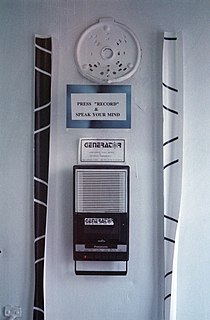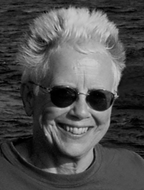
An electronic musical instrument or electrophone is a musical instrument that produces sound using electronic circuitry. Such an instrument sounds by outputting an electrical, electronic or digital audio signal that ultimately is plugged into a power amplifier which drives a loudspeaker, creating the sound heard by the performer and listener.

The cassette culture refers to the practices associated with amateur production and distribution of music and sound art on compact cassette that emerged in the 1970s. Whilst the cassette was used by fine artists and poets for the independent distribution of new work, this article focuses on the independent music scene associated with the cassette that burgeoned internationally in the second half of the 1970s.
Laurie Spiegel is an American composer. She has worked at Bell Laboratories, in computer graphics, and is known primarily for her electronic-music compositions and her algorithmic composition software Music Mouse. She also plays the guitar and lute.
Electroacoustic music is a genre of Western art music in which composers use technology to manipulate the timbres of acoustic sounds, sometimes by using audio signal processing, such as reverb or harmonizing, on acoustical instruments. It originated around the middle of the 20th century, following the incorporation of electric sound production into compositional practice. The initial developments in electroacoustic music composition to fixed media during the 20th century are associated with the activities of the Groupe de recherches musicales at the ORTF in Paris, the home of musique concrète, the Studio for Electronic Music in Cologne, where the focus was on the composition of elektronische Musik, and the Columbia-Princeton Electronic Music Center in New York City, where tape music, electronic music, and computer music were all explored. Practical electronic music instruments began to appear in the early 1900s.
UbuWeb is a web-based educational resource for avant-garde material available on the internet, founded in 1996 by poet Kenneth Goldsmith. It offers visual, concrete and sound poetry, expanding to include film and sound art mp3 archives.

Multitrack recording of sound is the process in which sound and other electro-acoustic signals are captured on a recording medium such as magnetic tape, which is divided into two or more audio tracks that run parallel with each other. Because they are carried on the same medium, the tracks stay in perfect synchronisation, while allowing multiple sound sources to be recorded at different times.
60x60 is a collection of 60 electroacoustic or acousmatic works from 60 different composers/artists, each work 60 seconds or less in duration. 60x60 project showcases sixty new works, each sixty seconds or less, by sixty composers in a continuous sixty-minute concert, for a one-hour cross-section of contemporary music. The 60x60 project was conceived and developed by the new music consortium, Vox Novus and its founder, Robert Voisey.

Robert Voisey is a composer and producer of electroacoustic and chamber music. He founded Vox Novus in 2000 to promote the music of contemporary composers and in 2001 created The American Composer Timeline, the first in-depth listing of American composers, spanning from 1690 to the present, to appear on the Internet. A producer of new music and multi-media concerts and events, Voisey is best known for producing the 60x60 project, which he started in 2003 in order to promote contemporary composers and their music. He also founded and directs the Composer's Voice Concert Series as well as the chamber music project Fifteen Minutes of Fame as well as vice president of programs for the Living Music Foundation.
George Brunner is an American composer and performer born in Philadelphia. He has founded the International Electroacoustic Music Festival at Brooklyn College in 1995 where he has produced renowned composers such as Pauline Oliveros and Noah Creshevsky. He is also the founder of the Brooklyn College Electroacoustic Music Ensemble. Currently, he is the Director of the Music Technology Program for the Conservatory of Music at Brooklyn College and on the faculty of the Brooklyn College Center for Computer Music (BC-CCM).
Brenda Hutchinson is an American composer and sound artist who has developed a body of work based on a perspective about interacting with the public and non-artists through personal, reciprocal engagement with listening and sounding. Hutchinson encourages her participants to experiment with sound, share stories, and make music. She often bases her electroacoustic compositions on recordings of these individual collaborative experiences, creating "sonic portraits" or "aural pictures" of people and situations.

Launched from the Lower East Side, Manhattan in 1983 as a subscription only bimonthly publication, the Tellus Audio Cassette Magazine utilized the audio cassette medium to distribute no wave downtown music and audio art and was in activity for the ten years of 1983–1993.

Peter van Riper was a sound and light environment artist, musician and pioneer of laser art and holography.
Power electronics is a style of noise music that typically consists of static, screeching waves of feedback, analogue synthesizers making sub-bass pulses or high frequency squealing sounds; with (sometimes) screamed and distorted vocals with hateful and offensive lyrics. The genre is noted for its influence from industrial.

viral symphOny is a collaborative electronic noise music symphony created by the postconceptual artist Joseph Nechvatal. It was created between the years 2006 and 2008 using custom artificial life C++ software based on the viral phenomenon model. It is 1 hour and 40 minutes in length. The first movement of viral symphOny - and raw viral field material - was released in 2006 as a CD by The Institute for Electronic Arts in Alfred, New York. A low resolution extract from the pOstmOrtem section of viral symphOny was published in NME magazine.

Novus Magnificat: Through the Stargate (1986) is an album by American musician Constance Demby, with additional sonic textures by composer Michael Stearns. The album sold over 200,000 copies worldwide It was voted in 2002 one of "The 25 Most Influential Ambient Albums of All Time".
Paul DeMarinis (1948) is an American visual and sound artist, specializing in electronic music composer, sound, performance, and computer-based artist. Since the 1970s he has been active in creating digital sound sculptures, one of the early innovators of sound art. He is currently a professor of art at Stanford University.
Stanley Keith Bowsza, better known by the pseudonym Minóy, was an American electronic musician and sound artist. He was a major figure in the DIY noise music and homemade independent cassette culture scene of the 1980s. He released over 100 compositions.

Generator Sound Art is an experimental arts and culture organization based in New York City, co-owned by the sound artists Gen Ken Montgomery and Scott Konzelmann. It focuses upon the work of dedicated Sound Artists, and is an umbrella organization that either facilitated or continues to facilitate the activities of the Generator Gallery / exhibition space, the Generations Unlimited audio recording label, and a second, eponymous audio recording label. Generator as a physical gallery / exhibition space existed in the East Village and then in Chelsea from 1989–1992.

Helen Louise Thorington is an American radio artist, composer, performer and writer. She is also the founder of New Radio and Performing Arts (1981), a nonprofit organization based in New York City; the founder and executive producer of New American Radio (1987-1998); and the founder and co-director of Turbulence.org (1996–2016).
Gregory Paul Kramer, is a composer, researcher, inventor, meditation teacher and author. In 1975 he co-founded Electronic Musicmobile, a pioneer synthesizer ensemble later renamed Electronic Art Ensemble, in which Kramer was a musician and the principal composer. His pioneering work extended to developing synthesizer and related equipment. Kramer also co-founded the not-for-profit arts organization Harvestworks in New York City. He is recognized as the founding figure of the intensely cross-disciplinary field of data sonification. Since 1980, Kramer teaches Buddhist meditation. He is credited as co-founder of Insight Dialogue, an interpersonal meditation practice. Kramer is the author of several books in diverse fields, as well as (co-)author of scientific papers in the field of data sonification.









